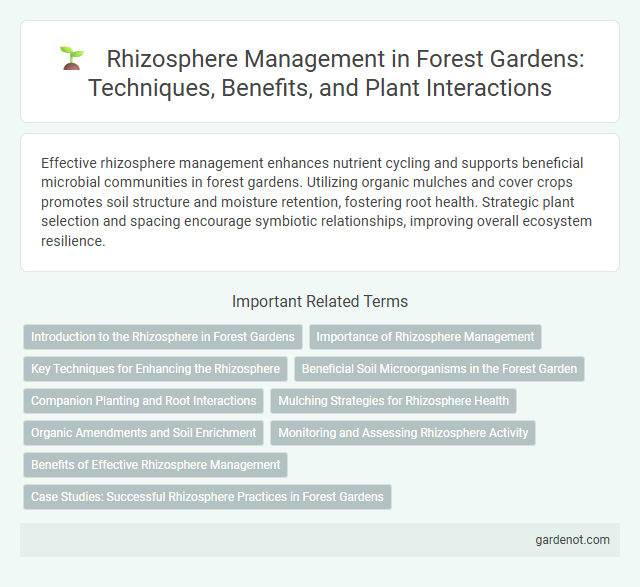Effective rhizosphere management enhances nutrient cycling and supports beneficial microbial communities in forest gardens. Utilizing organic mulches and cover crops promotes soil structure and moisture retention, fostering root health. Strategic plant selection and spacing encourage symbiotic relationships, improving overall ecosystem resilience.
Introduction to the Rhizosphere in Forest Gardens
The rhizosphere in forest gardens is a dynamic zone where plant roots interact with soil microorganisms, organic matter, and nutrients, crucial for ecosystem health and productivity. Effective rhizosphere management enhances nutrient cycling, supports beneficial microbial communities, and improves plant resilience to stress. Understanding root exudates and microbial symbiosis within this zone enables optimized growth and sustainable soil fertility in forest garden systems.
Importance of Rhizosphere Management
Rhizosphere management enhances nutrient cycling, improves soil structure, and promotes beneficial microbial activity critical for forest garden productivity. Maintaining a healthy rhizosphere supports root health and resilience against pests and diseases, directly influencing plant growth and yield. Optimizing rhizosphere conditions through organic amendments and minimal soil disturbance ensures sustainable forest garden ecosystems.
Key Techniques for Enhancing the Rhizosphere
Key techniques for enhancing the rhizosphere in forest gardens include biochar application to improve soil structure and moisture retention, mycorrhizal inoculation to boost nutrient uptake, and cover cropping to increase organic matter and support beneficial microbial communities. Incorporating diverse root exudate-producing plants stimulates microbial activity and nutrient cycling, optimizing plant health and growth. Regular monitoring of soil pH and moisture ensures the rhizosphere remains balanced and conducive to root symbiosis.
Beneficial Soil Microorganisms in the Forest Garden
Beneficial soil microorganisms such as mycorrhizal fungi and nitrogen-fixing bacteria enhance nutrient cycling, improve soil structure, and increase plant resilience in forest gardens. Effective rhizosphere management promotes symbiotic relationships between these microbes and plant roots, boosting growth and health. Incorporating organic mulches and diverse plant species supports a thriving microbial community essential for sustainable forest garden productivity.
Companion Planting and Root Interactions
Rhizosphere management in forest gardens emphasizes companion planting to enhance beneficial root interactions, promoting nutrient exchange and microbial activity. Strategic selection of plant species with complementary root systems improves soil structure and increases resilience against pests and diseases. These synergistic root relationships optimize resource use, supporting sustainable growth and biodiversity within the forest garden ecosystem.
Mulching Strategies for Rhizosphere Health
Mulching strategies in forest gardens play a critical role in enhancing rhizosphere health by regulating soil moisture, temperature, and nutrient availability. Organic mulches, such as leaf litter, wood chips, and compost, promote beneficial microbial activity and improve soil structure, fostering robust root development. Effective rhizosphere management through targeted mulching increases nutrient cycling efficiency and suppresses weed growth, which supports sustainable plant productivity and biodiversity.
Organic Amendments and Soil Enrichment
Organic amendments such as compost, biochar, and green manure play a crucial role in rhizosphere management by enhancing soil fertility and microbial activity in forest gardens. Applying these amendments increases nutrient availability, promotes beneficial mycorrhizal fungi, and improves soil structure, leading to healthier root systems and increased plant resilience. Consistent enrichment of the rhizosphere through organic inputs supports sustainable nutrient cycling and long-term productivity in agroforestry ecosystems.
Monitoring and Assessing Rhizosphere Activity
Monitoring and assessing rhizosphere activity involves analyzing root exudates, microbial population dynamics, and soil enzyme activities to optimize nutrient cycling in forest gardens. Tools such as soil respiration measurements, root imaging, and molecular techniques like qPCR provide essential data on microbial interactions and root health. Accurate rhizosphere management enhances plant growth, soil fertility, and resilience against pathogens within diverse forest garden ecosystems.
Benefits of Effective Rhizosphere Management
Effective rhizosphere management enhances nutrient uptake, promoting robust tree growth and increased fruit yield in forest gardens. By optimizing microbial activity and root-soil interactions, it improves soil structure and disease resistance, reducing the need for chemical inputs. This sustainable approach supports biodiversity and long-term ecosystem health, vital for productive forest garden systems.
Case Studies: Successful Rhizosphere Practices in Forest Gardens
Case studies in forest gardens reveal that effective rhizosphere management enhances plant health and productivity by optimizing soil microbial communities and nutrient cycling. Techniques such as inoculating beneficial mycorrhizal fungi, applying biochar to improve soil structure, and incorporating deep-rooted perennial species have demonstrated significant increases in carbon sequestration and plant resilience. These practices collectively promote sustainable forest garden ecosystems with improved biodiversity and long-term soil fertility.
Rhizosphere management Infographic

 gardenot.com
gardenot.com